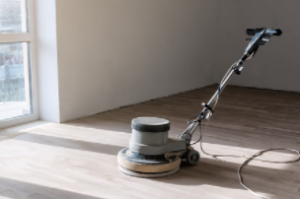Before starting floor sanding, you must know the steps you have to take. First, you must be very careful not to sand too deeply, or you may leave indents in the wood. If you have a hardwood floor, be sure to sand the floorboards first before staining or painting them. After sanding, you should vacuum the floor and apply a finish. This will make the sanding process easier.
 To prepare the floor for sanding, you must first sweep the floor. Then, you can use a wet cloth to clean the surface. You can also vacuum the area around the edges. While sanding, you should be careful not to leave grit on the sanding pad or disc. The grit could clog the pad or disc and cause gouges. Before you start sanding, you should examine the floor thoroughly to ensure no cracks have developed.
To prepare the floor for sanding, you must first sweep the floor. Then, you can use a wet cloth to clean the surface. You can also vacuum the area around the edges. While sanding, you should be careful not to leave grit on the sanding pad or disc. The grit could clog the pad or disc and cause gouges. Before you start sanding, you should examine the floor thoroughly to ensure no cracks have developed.
To prevent scuff marks, make sure you change sandpaper frequently. You should change the paper if the sanders are not heavy enough. If you’re hiring a sander, remember to buy paper from the rental company. You can always return it if it’s too worn. And before sanding, you should check the floor with a hand-held mirror. After sanding, clean up any debris, repair cracks, and vacuum it.
Before sanding your floor, you need to remove any obstructions. For instance, heating grates and old carpet tacks must be removed. Baseboards should be left in place. It would help if you cleaned the floor before sanding it, so make sure to dust mop it and remove any loose debris. You may also need to repair any cracks in the floor. To avoid these issues, you need to hire a professional from floorsandingandpolishingadelaide.com.au.
Before sanding your floors, you must remove any old carpet tacks and heating grates. Baseboards should be removed. Before sanding, you should sweep and dust mop the floor thoroughly to remove debris. If you’re sanding your floor, you should remove any damaged flooring and any cracks. If you’re a DIY-er, you can also hire a professional to sand your floors.
Before floor sanding, you need to remove any old carpet tacks and heating grates. Older flooring may also be cracked or damaged. Before sanding, you need to clean the floor thoroughly to ensure that the sanding process will not create any scuff marks. Sanding is the best option if you want a new look for your floors. Not only does it look good, but it will increase the value of your home and increase its value.
Before floor sanding, make sure you remove any damaged furniture, old carpet tacks, and baseboards. Before sanding, you need to sweep the floor. You must also dust mop to remove any loose debris and dust. If you don’t want to sand your floors yourself, you should hire a professional. A good technician will ensure the cleanliness of your home’s floors.
Before sanding, you should remove old carpet tacks, heating grates, and baseboards. Afterwards, it would help to sweep the floor to remove any debris. Dust mop it again once the floor is clean to remove any loose particles. If there are any cracks, you should repair them. It will be easier to sand your floors if you use a sander with a large capacity.
Before floor sanding, you should remove the heating grates, old carpet tacks, and baseboards. Before sanding, you should remove old carpet tacks, dust-mop the floor, and repair any cracks in the floor. You should wear protective gear during the sanding process, including eye protection. You should also wear ear and face masks to prevent inhaling the dust.
Before floor sanding, you should think about the safety of yourself and others. The sander produces dust and is loud. It can cause splinters. You should wear gloves and eye protection. A facemask is essential. The wood dust is toxic and should be kept away from the eyes and the body. Keeping your family safe is the top priority, so you should focus on protecting yourself and your home.

Leave a Reply